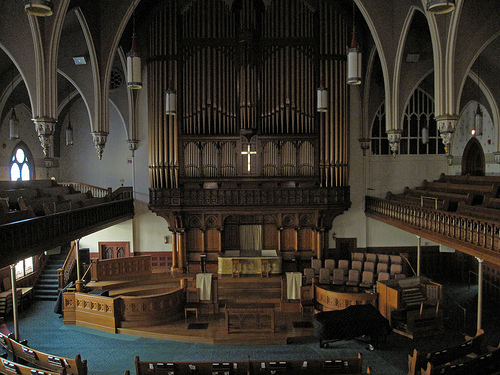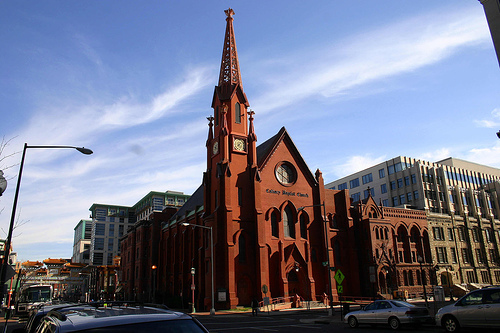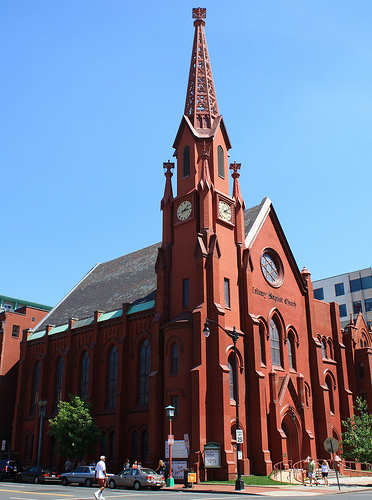Building of the Week: Calvary Baptist Church
The name Adolf Cluss may not ring a bell for you, but you probably know his work: he designed Eastern Market and Smithsonian’s Art and Industries Building. One of his lesser-known red brick creations, typical of late 19th century architecture in the region, is the Calvary Baptist Church in Chinatown.
The red pressed brick church rises above the corner of 8th Street and H Street in northwest. A collaboration between Cluss and Joseph Wildrich von Kammerhueber, it was completed in 1866.
The church is best known for its iron spire. Likely inspired by the Freiburg Cathedral in Germany, the open design gives the elaborate metalwork a graphic quality. Cluss drew attention to the tower by giving the church asymmetrical massing.
However, the interior of the church differs from what Cluss and Kammerhueber originally designed. A fire during a blizzard in 1867 destroyed the interior in 1867, and some people say that happened because Cluss designed a faulty heating system.
After the fire, alterations to the interior during reconstruction included balconies on he north and south sides of the sanctuary, and a new organ. These additions obstruct parts of the stained glass.

The interior of the Calvary Baptist Church with the balconies blocking the original windows. Image by StreetsofWashington on Flickr.
The church lacked its iconic spire for much of the 20th century. Removed after a lightning strike in 1914, it was only reconstructed along with the belfry in 2005.
Progressive history
The Calvary Baptist Church and its two connected sites are protected historic buildings, owing to the church’s progressive mission and contributions to the downtown DC historic district. The Baptists supported the Union during the Civil War with a mission that was — and remains — welcoming to all races and ethnicities.
This progressive policy sets the church apart from the numerous other congregations that Cluss built churches for in the Washington region from 1884 to 1886. Such forward thinking mirrored Cluss’s fearless architectural ideals.
Today, the Calvary Baptist Church continues to fulfill its mission by offering bilingual services in Spanish, including marriage equality activists in its congregation, and ordaining what may have the first transgender woman to the gospel ministry.
The structure is also considered a contributing building to the Downtown Historic District, which is considered the “heart of the old downtown, with an eclectic mixture of commercial, institutional, and residential buildings…” Such a description could easily be applied to the work of Cluss himself.
An architect and engineer, Cluss designed schools, government buildings, homes, museums, and churches around Washington DC during the last decades of the 19th century. He also oversaw major civic improvements, like pacing streets, construction of sewers and planting street trees, as city engineer to the capital.



